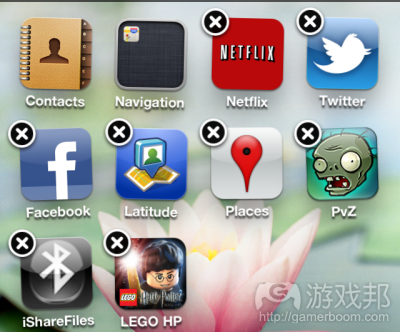应用开发者如何避免产品被用户删除?
作者:Helpshift
每天,这个世界上都有成百上千万人遭遇“应用自杀现象”——这些手机应用没有提供优良的移动体验,迫使我们不得不将其删除。事实上,有调查显示,我们每10人中平均只有3人会让一款手机应用在设备上保存90天时间。
这种大规模的应用删除现象是完全可以避免的——毕竟,没有人愿意无故删除一款应用。我们每下载一款新应用,就会希望这种移动体验能够让我们不断重返其中。
但面对如此之众,并且不断增长的竞争对手,开发者要持续取悦用户,保证用户忠诚实非易事。一招不慎就有可能愤怒、困惑、抓狂的用户删除你的应用。
手机用户就是这种浮躁、容易背叛,只需轻点手指就可以无情地把你投入所有时间、精力和金钱所开发的应用删除的群体吗?没错,但是不要恨玩家,不要恨游戏,而是要修补游戏。毕竟,如果是你自己,还会重返一家服务质量有问题(虽然他们也花时间为你做饭)的餐厅吗?
除了制作一款有用、设计精良、出色的应用,你还得努力提升手机用户留存率和粘性,避免出现可能损害用户增长潜力的一颗星评价:
1.持续吸引用户。约有四分之一的应用仅被访问一次就被删除了,所以第一印象真的很重要。一定要向新用户发出有用的问候信息,或者直观的产品导航。
2.了解你的用户。知识就是力量。要看看用户群体特点,了解特定用户群体在你的应用内外有何行为表现。如果不了解为何有些用户很忠诚,而有些用户却会离开应用,那么你就无法优化产品获得成功。如果需要进行应用分析,推荐使用Flurry、Distimo、Localytics以及Onavo Insights。
3.进行测试。在你掌握用户数据之后,就要进行测试。使用A/B测试法引导特定用户进行不同体验,并确定哪种方法最为成功。
4.提供出色的客服支持。许多应用都只成功实现了前面3页,但仍然无法令用户满意。为什么?因为在用户存疑的关键时刻、体验中的漏洞,对最近更新内容的困惑,或者需要帮助时,却没有得到相应的回应。所以抓狂的用户会删除应用(游戏邦注:如果他们真的很生气,或者会通过社交媒介散布自己的不满情绪,甚至在应用商店留下负面评价)。你可以使用Helpshift等服务,创造FAQ自助服务,提醒用户注意漏洞和更新内容,并在应用内部获取反馈和提供帮助,这可以在减少成本的同时极大提升用户留存率。
5.持续迭代。人很容易厌倦,要使用你通过应用分析、A/B测试以及用户反馈获得的信息来更新应用,开发新功能,创造新颖而令人兴奋的内容。
6.恢复用户活力。我们可以重新“激活”已流失的用户,以强化广告、营销以及奖励下载等付费渠道,以及非付费渠道(例如自然搜索/浏览,口头传播等)的新用户获取手段。记住,如果你通过用户和请求反馈(见第1-4项)掌握信息,你就能够划分用户群组,并向他们发送信息以增进他们同应用的互动。
7.持续而不懈地执行以上所有事项。
你的应用终身收益部分取决于你如何吸引新用户,并长期提供独特而富有吸引力的体验。你可以利用下一代应用分析、应用测试和客服工具来提供独一无二的手机用户体验,以便保证用户满意度和粘性。(本文为游戏邦/gamerboom.com编译,拒绝任何不保留版权的转载,如需转载请联系:游戏邦)
Thousands of apps committing ‘appicide’ — and the numbers are growing
This sponsored post is produced by Helpshift.
Every day, millions of us around the world are affected by “appicide”: mobile apps forcing users to delete them by failing to provide a superior mobile experience. In fact, research shows that only 3 out of 10 of us on average will keep a mobile app on our devices after 90 days.
This mass appicide is completely preventable—after all, no one wants to delete an app. Every time we download a new app, we hope for a mobile experience that will keep us coming back time and time again.
But with an ever-expanding universe of mobile apps just a few taps away, keeping mobile users happy and loyal can be tricky. Make one wrong move that angers, confuses, or frustrates users and chances are you’ll get deleted.
Are mobile users a fickle, disloyal bunch whose ruthless fingers will feel no guilt when they delete your app after all the time, energy, and money you put into creating it? Yes. But don’t hate the players; hate the game—and then fix the game. After all, would you keep going back to a restaurant with bugs or poor service even though they took the time to prepare your meal for you? Didn’t think so.
Skipping past having a useful, well-designed, compelling app to start with (without this, you’re dead in the water), here’s how you can improve mobile app user retention and engagement—and avoid one-star App Store reviews that can kill future user acquisition.
Keep users onboard. About a quarter of all apps will only be opened only once before they are deleted, so the old adage about first impressions holds true. Be sure to greet new users with useful greeting messages or an intuitive product tour.
Learn about your users. Knowledge is power. Look at demographics and learn how certain groups of users behave inside and outside of your app. You won’t be able to optimize for success without knowing why some are power users while others are leaving your app. For app analytics, check out Flurry, Distimo, Localytics, and Onavo Insights.
Get to testing. Once you have data on your users, get to testing. Utilize A/B testing (colloquially called “experimentation”) to guide certain users through different experiences and determine which paths are the most successful. Check out Leanplum for mobile A/B testing.
Provide unparalleled service and support. Many apps successfully do steps 1-3, but they still fail at keeping users happy. Why? Because at the critical, inevitable moment when users have questions, or experiences bugs, or are confused by a recent update, or need any kind of help, they can’t get it. So frustrated users delete the app altogether (and if they’re really upset, they may call your app out on social media and leave a negative app store review). With Helpshift, you can create self-service FAQs, alert users to bugs and updates, and get feedback and provide support entirely in-app, which can dramatically improve user retention while cutting costs.
Iterate constantly. Humans get bored, so use the information you get from app analytics, AB/testing, and user feedback to update your app, develop new features, and create new and exciting content.
Reactivate. New user acquisition from paid sources like advertising, marketing, and incentivized downloads as well as non-paid sources (e.g. organic search/browsing, word of mouth, etc.) can be augmented by reactivating users who dropped off. Remember: If you have learned from users and solicited feedback (see steps 1-4) you’ll be able to segment groups of users and send them messages that re-engage them with your app.
Do all of these things constantly and unwaveringly.
The lifetime revenue from your app depends in part on how well you can attract new users and provide a unique and engaging experience over time. You have an opportunity to leverage next-generation tools for app analytics, app testing, and customer service to provide a unique and compelling mobile customer experience that keeps users happy and coming back.(source:venturebeat)
上一篇:关于免费游戏的一些问题与解答








































 闽公网安备35020302001549号
闽公网安备35020302001549号